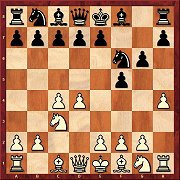Video introduction by GM Karsten Müller
Free opening survey - download a sample!
Michal Krasenkow: "No compromises" (Dutch A85: 1.d4 f5 2.c4 Nf6 3.Nc3 g6 4.h4)
 GM Michal Krasenkow from Poland presents you a sharp weapon against the Dutch Defence. After 14d4 f5 2.c4 Nf6 3.Nc3 g6 White immediately attacks the black setup with 4.h4.
GM Michal Krasenkow from Poland presents you a sharp weapon against the Dutch Defence. After 14d4 f5 2.c4 Nf6 3.Nc3 g6 White immediately attacks the black setup with 4.h4.
The most common reply now is 4...Bg7 but that is exactly where Black starts to go wrong! In his new article Krasenkow shows you how White can cause the black king big troubles ater the almost forced moves 5.h5 Nxh5 6.e4! fxe4 7.Rxh5!
The better choice is 4...d6, but also here White will sacrifice the exchange after 5.h5 Nxh5 6.Rxh5 with at least good practical chances.
Click here to download the pdf file...
Click here to download the full article for ChessBase 12...
Opening surveys
Michal Krasenkow: Dutch A85 1.d4 f5 2.c4 Nf6 3.Nc3 g6 4.h4

In this sharp variation White follows up with h4-h5 and then he must not be afraid to offer an exchange on h5. There is no proof of any direct opening advantage according to Michal Krasenkow, but Black is faced with a difficult defensive task.
Schipkov: Dutch A85 1.d4 f5 2.c4 Nf6 3.Nc3 d6 4.Bg5

If Black wants to avoid the above variation, but nevertheless still aim for the Leningrad System, there is always the changing of move order with 3...d6. Boris Schipkov then examines 4.Bg5, which brings to the board independent variations – where the theory is as yet under-developed.
Szabo: Sicilian B85 1.e4 c5 2.Nf3 d6 3.d4 cxd4 4.Nxd4 Nf6 5.Nc3 a6 6.Be2 e6 7.0-0 Be7 8.f4 0-0 9.Be3 Nc6 10.a4 Qc7 11.¢h1 Re8 12.Bf3 Bd7 13.Nb3

With 12...Bd7 Black is aiming for ...Nxd4 and ...Bc6, but the white knight avoids the exchange. The theory then goes far into the middlegame. Krisztian Szabo shows in his article that Black can hardly count on equality.
Schandorff: Sicilian B97 1.e4 c5 2.Nf3 d6 3.d4 cxd4 4.Nxd4 Nf6 5.Nc3 a6 6.Bg5 e6 7.f4 Qb6 8.Qd2 Qxb6 9.Rb1 Qa3 10.e5 h6

Development in the Poisoned Pawn Variation is driven above all by computer games. So, for his article Lars Schandorff has to great extent turned to the Najdorf Powerbook 2013 and come to some remarkable conclusions.
Karolyi: Ruy Lopez C80 1.e4 e5 2.Nf3 Nc6 3.Bb5 a6 4.Ba4 Nf6 5.0-0 Nxe4 6.d4 b5 7.Bb3 d5 8.dxe5 Be6 9.Nbd2 Bc5

The move 9...Bc5 is actually only the third choice (after 9...Be7 and 9...Nc5), but Tibor Karolyi proves with his extensive analyses that Black can count on good chances of equality.
Stohl: Ruy Lopez C88 1.e4 e5 2.Nf3 Nc6 3.Bb5 a6 4.Ba4 Nf6 5.0-0 Be7 6.Re1 b5 7.Bb3 0-0 8.a4 b4

People still avoid the Marshall Attack. One quite popular variation is the one with 8.a4 b4 and then either 9.d3 or 9.d4. According to Igor Stohl White does not obtain an advantage with it, but over the board he gets playable positions.
Postny: Grünfeld Defence D90 1.d4 Nf6 2.c4 g6 3.Nc3 d5 4.Nf3 Bg7 5.h4

Variations with h4 are fashionable, so why not against the Grünfeld Defence? All the relevant games are from 2013. Evgeny Postny shows in his article that Black gets decent play after both 5...c6 and also 5...dxc4.
Sumets: Grünfeld Defence D94 1.d4 Nf6 2.c4 g6 3.Nc3 d5 4.Nf3 Bg7 5.e3 0-0 6.cxd5 Nxd5 7.Bc4

Of course the Closed Variation (5.e3) is not an attempt to refute the Grünfeld Defence, it is more about enticing Black into unknown territory. Contrary to the trend Andrey Sumets considers that from the diagram the reply 7...Nxc3 is the safest.
Arnaudov: Tango E04/E10 1.d4 Nf6 2.c4 e6 3.Nf3 Nc6 4.g3 d5 5.Bg2 dxc4

In the second part of his series on the Tango Petar Arnaudov looks into the reply 4.g3, after which Black can only transpose to another opening. Our author pleads in favour of 4...d5 5.Bg2 dxc4, when a popular but easy to learn variation of the Catalan is on the board.
Illingworth: Catalan E05 1.d4 Nf6 2.c4 e6 3.g3 d5 4.Nf3 Be7 5.Bg2 0-0 6.0-0 dxc4 7.Ne5 Nc6 8.Bxc6 bxc6 9.Nxc6 Qe8 10.Nxe7+ Qxe7

Vladimir Kramnik gave an impetus to this variation when he played 11.Qc2 (instead of the usual 11.Qa4) against Magnus Carlsen in the candidates tournament and obtained an advantage. Max Illingworth has examined both moves in depth and can refer to numerous contemporary games.
Antic: Bogoindian E11 1.d4 Nf6 2.c4 e6 3.Nf3 Bb4+ 4.Nbd2 0-0 5.a3 Be7 6.e4 d5 7.e5 Nfd7 8.Bd3 c5 9.h4

In recent years Black has obtained good results with the variation after 6...d5. But the setup with 9.h4 could turn out to be dangerous. Dejan Antic shows that 9...h6 is practically refuted; after 9...g6 there are certainly a lot of discoveries waiting to be made.
Marin: Nimzoindian E59 1.d4 Nf6 2.c4 e6 3.Nc3 Bb4 4.e3 0-0 5.Bd3 d5 6.Nf3 c5 7.0-0 Nc6 8.a3 Bxc3 9.bxc3 dxc4 10.Bxc4 Qc7 11.Bd3 e5 12.Qc2

Mihail Marin presents detailed analysis of a variation which has recently somewhat gone out of fashion. But things do not have to remain like that. According to our author White’s resources are not yet exhausted.


 GM Michal Krasenkow from Poland presents you a sharp weapon against the Dutch Defence. After 14d4 f5 2.c4 Nf6 3.Nc3 g6 White immediately attacks the black setup with 4.h4.
GM Michal Krasenkow from Poland presents you a sharp weapon against the Dutch Defence. After 14d4 f5 2.c4 Nf6 3.Nc3 g6 White immediately attacks the black setup with 4.h4.










